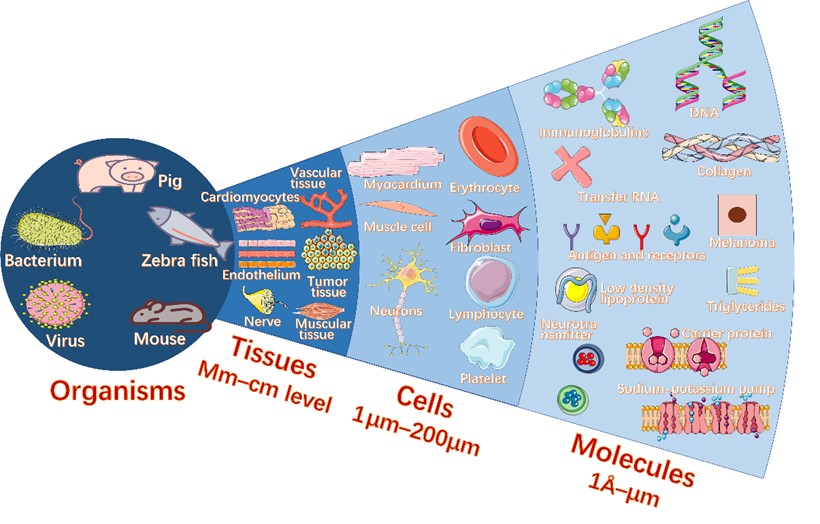
Time:2022-04-21 Read:1489
The laser is considered one of the greatest inventions of the 20th century. Biolasers employ high signal-to-noise ratio lasing emission rather than regular fluorescence as the sensing signal, directional out-coupling of lasing and excellent biocompatibility. Meanwhile, biolasers can also be micro-sized or smaller lasers with embedded/integrated biological materials. This article presents the progress in biolasers, focusing on the work done over the past years, including the molecular, cellular, tissue, and organism levels. Furthermore, biolasers have been utilized and explored for broad applications in biosensing, labeling, tracking, bioimaging, and biomedical development due to a number of unique advantages. Finally, we provide the possible directions of biolasers and their applications in the future.
An embryo in its first stage of life undergoes an extraordinary transformation from a single cell to a dozens of centimeters long fetus with immune, digestive, and nervous systems, limbs and toes, etc. Tissue engineering involves myriad cellular and molecular events of complexity. Therefore, studying the various bioactivities at the molecular, cellular, tissue, and even living organism levels is very important to life science. Furthermore, the research provides a way to comprehend life’s nature and meaning. The most recent review and perspective papers on kinds of methods were published a decade ago. The specific fluorescence of a molecular trajectory is tracked by kinds of super-resolution methods from the fluorescence, material, and nanotechnology fields. As we know, a large number of molecules comprise a cell, and various functional cells construct a tissue or organ, and there are many methods of researching cell bioactivities and tissue functions. A tremendous amount of research has been undertaken, with a significant number of papers published. Compared to fluorescence, material, and nanotechnology, laser emission is an ad-vanced method to detect various bioactivities at any life level. Biological lasers have many advantageous points in applications. The strong intensity of the laser beam leads to a high signal-to-noise ratio. The directional out-coupling of lasing is easily detected and monitored, and the perfect and high-sensitivity optical feedback mechanism sens-es small changes in biological processes in real time. Moreover, the narrow linewidth of the lasing beam leads to spectrally multiplexed detection, imaging, and tracking.
Owing to the strengths of biolasers, kinds of biolasers have been utilized to detect or monitor various bioactivities at the molecular, cellular, tissue, and organism levels. Recently, their applications in cell tracking, label-ing/probes, implantable devices, and cell/tissue imaging have started to emerge. How-ever, molecular, cell, and tissue functions should be independently distinguished in the complex biological field, and all of the previous reviews have not separated and de-scribed various bioactivities at the molecular, cellular, tissue, and organism levels with kinds of biological lasers. In this review, we discuss distinct biolasers and their poten-tial biological and biomedical applications at all levels, as shown in Figure. In the end, we present an outlook on the possible challenges and future directions of biolasers.

Figure. The overview of biolasers in different life levels, including organisms, tissues, cells, and molecules.
The research was published in “Shan, H.; Dai, H.; Chen, X. Monitoring Various Bioactivities at the Molecular, Cellular, Tissue, and Organism Levels via Biological Lasers. Sensors 2022, 22, 3149”.
Link: https://www.mdpi.com/1424-8220/22/9/3149